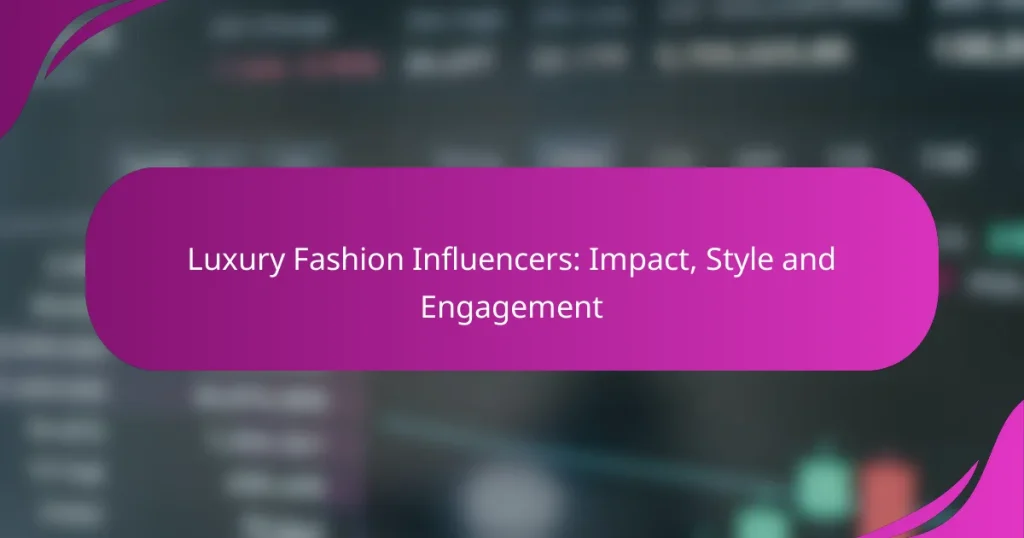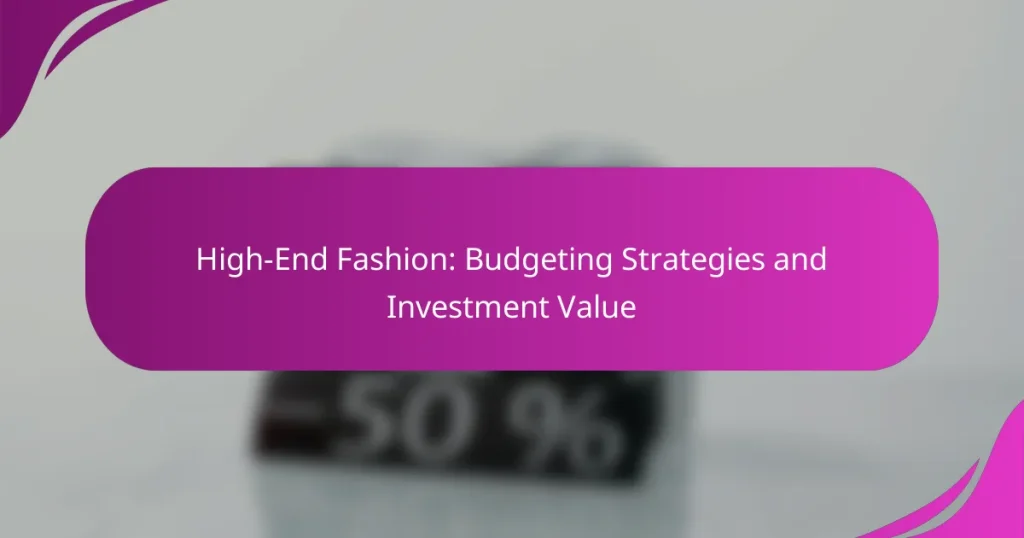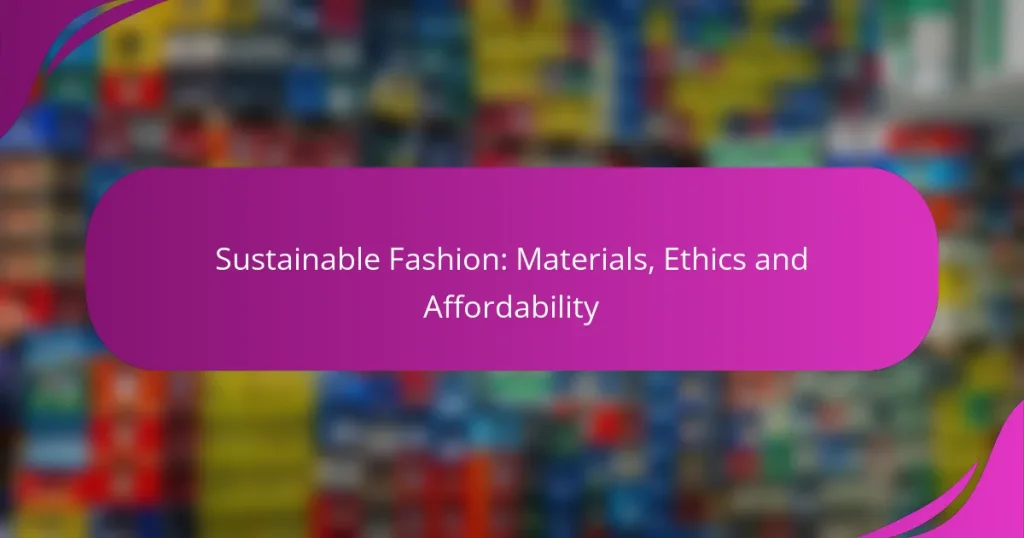Luxury fashion trends are evolving to emphasize both bold aesthetics and sustainable practices, reflecting a growing consumer demand for individuality and craftsmanship. As designers innovate with materials and create statement pieces, discerning buyers must consider quality, brand reputation, and exclusivity when investing in high-end fashion items.
High-End Fashion: Budgeting Strategies and Investment Value
Custom Tailoring: Fit, Personalization and Quality
Online Boutiques: Selection, Quality and Customer Experience
Fashion Weeks: Trends, Influences and Market Dynamics
Sustainable Fashion: Materials, Ethics and Affordability
Designer Brands: Selection Criteria, Style Compatibility and Quality
What are the latest luxury fashion trends in the US?
The latest luxury fashion trends in the US showcase a blend of bold aesthetics and sustainable practices. Designers are increasingly focusing on innovative materials and statement pieces that reflect individuality and craftsmanship.
2023 Fall/Winter runway highlights
The 2023 Fall/Winter runway shows have emphasized oversized silhouettes and layered looks, with many designers opting for dramatic cuts and textures. Key themes include a revival of vintage styles, particularly from the 70s and 90s, combined with modern twists that appeal to contemporary tastes.
Accessories have taken center stage, with statement belts, chunky boots, and oversized bags dominating the collections. These elements not only enhance outfits but also serve as focal points that elevate overall looks.
Popular luxury brands: Gucci, Prada, Louis Vuitton
Gucci continues to push boundaries with its eclectic designs and bold prints, often incorporating elements of streetwear into high fashion. Prada is recognized for its minimalist yet sophisticated approach, focusing on clean lines and innovative fabrics that resonate with modern consumers.
Louis Vuitton remains a staple in luxury fashion, showcasing timeless elegance while experimenting with artistic collaborations. The brand’s iconic monogram is frequently reimagined, appealing to both traditionalists and trendsetters alike.
Key color palettes and materials
This season, earthy tones such as olive green, burnt orange, and deep browns are prevalent, reflecting a connection to nature and sustainability. These colors are complemented by rich textures like velvet, leather, and wool, which add depth and warmth to winter wardrobes.
Additionally, metallics and bold jewel tones are making a statement, particularly in evening wear. Fabrics like recycled polyester and organic cotton are gaining traction, aligning with the growing demand for sustainable luxury options.
How to choose luxury fashion items?
Choosing luxury fashion items involves assessing quality, brand reputation, and exclusivity. Focus on craftsmanship, materials, and the brand’s heritage to ensure your investment is worthwhile.
Identifying quality craftsmanship
Quality craftsmanship is essential when selecting luxury fashion items. Look for details such as stitching, fabric quality, and finishing. Items should feel substantial and well-made, often using high-grade materials like silk, cashmere, or fine leather.
Examine the seams and linings; hand-stitched elements typically indicate superior craftsmanship. Additionally, consider the weight of the item; heavier garments often signify better quality due to the materials used.
Understanding brand heritage and exclusivity
Brand heritage plays a crucial role in luxury fashion. Established brands often have a rich history and a reputation for quality, which can enhance the value of their items. Research the brand’s background, including its founding story and evolution over time.
Exclusivity is another key factor. Limited edition items or those produced in small quantities tend to retain their value better. Look for brands that emphasize exclusivity through unique designs or collaborations, as these pieces are often more sought after.
What are the pricing ranges for luxury fashion?
Luxury fashion pricing varies significantly based on brand, materials, and exclusivity. Generally, luxury items can range from several hundred to tens of thousands of dollars, depending on the product category and designer reputation.
Average price points for designer handbags
Designer handbags typically start around $1,000 and can exceed $10,000 for limited editions or highly sought-after brands. Popular brands like Louis Vuitton and Chanel often have entry-level bags in the $1,500 to $3,000 range, while exclusive pieces can reach upwards of $20,000.
When considering a designer handbag, it’s essential to factor in resale value, as many luxury bags retain or even appreciate in value over time. Researching market trends and brand popularity can help in making a wise investment.
Cost of bespoke clothing services
Bespoke clothing services usually start at around $2,000 and can go well beyond $10,000, depending on the tailor’s reputation and the complexity of the design. Custom suits, for example, often range from $3,000 to $7,000, while bespoke evening gowns can be priced similarly or higher.
Choosing bespoke clothing involves considering fabric quality, design intricacies, and the number of fittings required. It’s advisable to communicate clearly with your tailor about your preferences and budget to ensure a satisfactory outcome.
Where to buy luxury fashion in major US cities?
Major US cities offer a variety of options for purchasing luxury fashion, from high-end department stores to exclusive boutiques. Each location has its unique shopping experience, catering to different tastes and preferences.
Top luxury department stores in New York
New York City is home to some of the most prestigious luxury department stores in the world. Notable establishments include Bergdorf Goodman, Saks Fifth Avenue, and Neiman Marcus, each offering a wide selection of designer brands and personalized shopping experiences.
When shopping at these department stores, consider visiting during off-peak hours for a more relaxed experience. Look out for seasonal sales, which can provide significant discounts on luxury items, often ranging from 20% to 50% off.
Exclusive boutiques in Los Angeles
Los Angeles boasts a vibrant scene of exclusive boutiques that feature both established and emerging designers. Areas like Melrose Avenue and Rodeo Drive are known for their high-end shops, where you can find unique pieces that reflect the latest fashion trends.
While exploring these boutiques, be prepared for a more personalized shopping experience. Many boutiques offer styling consultations, allowing you to discover pieces that suit your individual style. Keep an eye out for limited-edition items, which can enhance your wardrobe with distinctive luxury fashion.
What are the benefits of investing in luxury fashion?
Investing in luxury fashion offers numerous advantages, including long-term value retention and the ability to enhance personal style and status. These benefits make luxury items not just a purchase, but a strategic investment in one’s wardrobe and social standing.
Long-term value and resale potential
Luxury fashion items often retain their value better than mass-produced goods, making them a smart investment. High-demand brands like Chanel, Hermès, and Louis Vuitton can see resale prices that are significantly higher than their original retail costs, sometimes appreciating by 20% or more over time.
When considering resale, condition and rarity play crucial roles. Limited edition pieces or those in pristine condition can fetch premium prices on resale platforms. It’s advisable to keep original packaging and receipts to maximize resale potential.
Enhancing personal style and status
Luxury fashion allows individuals to express their unique style while also signaling social status. Wearing high-end brands can create a perception of sophistication and success, which can be beneficial in both personal and professional settings.
To enhance personal style, consider investing in timeless pieces that can be mixed and matched with everyday clothing. Items like a classic designer handbag or tailored coat can elevate any outfit, making them versatile staples in your wardrobe.
What are the risks associated with luxury fashion purchases?
Luxury fashion purchases come with several risks, including the potential for counterfeit products and the depreciation of certain non-heritage brands. Buyers should be aware of these factors to make informed decisions and protect their investments.
Counterfeit concerns
Counterfeiting is a significant issue in the luxury fashion market, with many consumers unknowingly purchasing fake products. High demand for luxury items often leads to an influx of counterfeit goods, especially online. To avoid this risk, always buy from reputable retailers or directly from the brand.
Look for signs of authenticity, such as quality stitching, proper branding, and serial numbers. Additionally, consider using authentication services when purchasing high-value items from secondary markets.
Depreciation of non-heritage brands
Not all luxury brands hold their value equally, and non-heritage brands can depreciate significantly over time. While established brands like Chanel or Louis Vuitton often retain or even increase in value, newer or less recognized labels may not have the same resale potential.
When investing in luxury fashion, research the brand’s market position and resale history. Consider items that are classic and timeless, as they are more likely to maintain their value compared to trendy pieces that may fall out of favor.






